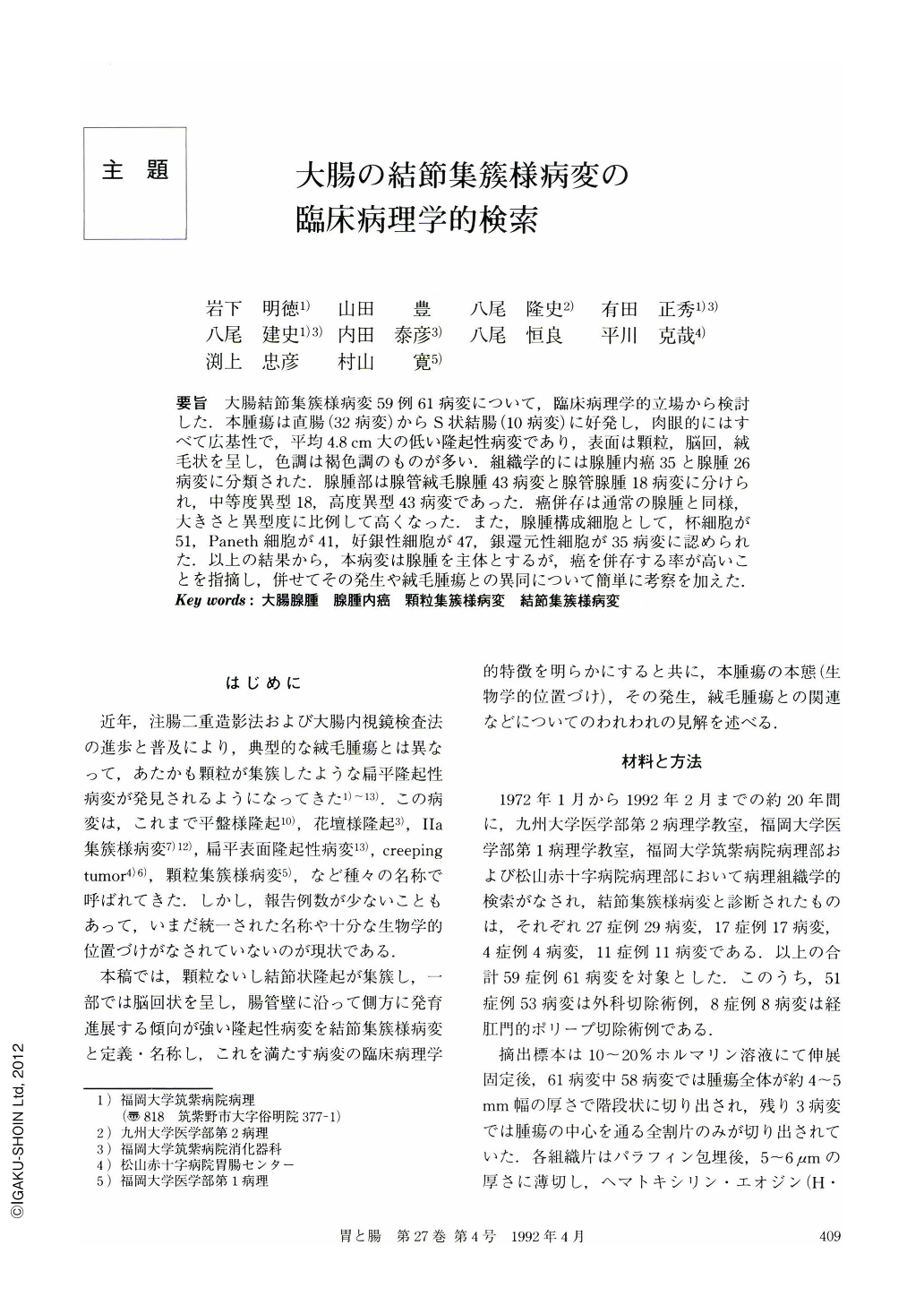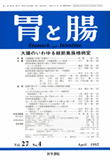Japanese
English
- 有料閲覧
- Abstract 文献概要
- 1ページ目 Look Inside
- サイト内被引用 Cited by
要旨 大腸結節集籏様病変59例61病変について,臨床病理学的立場から検討した.本腫瘍は直腸(32病変)からS状結腸(10病変)に好発し,肉眼的にはすべて広基性で,平均4.8cm大の低い隆起性病変であり,表面は顆粒,脳回,絨毛状を呈し,色調は褐色調のものが多い.組織学的には腺腫内癌35と腺腫26病変に分類された.腺腫部は腺管絨毛腺腫43病変と腺管腺腫18病変に分けられ,中等度異型18,高度異型43病変であった.癌併存は通常の腺腫と同様,大きさと異型度に比例して高くなった.また,腺腫構成細胞として,杯細胞が51,Paneth細胞が41,好銀性細胞が47,銀還元性細胞が35病変に認められた.以上の結果から,本病変は腺腫を主体とするが,癌を併存する率が高いことを指摘し,併せてその発生や絨毛腫瘍との異同について簡単に考察を加えた.
Clinicopathological study on colorectal flat elevation with conglomerated nodular surface was carried out in 61 resected specimens obtained from 59 patients.
Colorectal flat elevation with conglomerated nodular surface was macroscopically defined as a flat elevation with granular, villous and/or gyrus-like surface and with a tendency to horizontally extend.
The results obtained were as follows :
1) The average age of the patients (twenty-six males and thirty three females) was 62 years. Tumors were most frequently found in the rectosigmoid colon (42 out of 61 lesions).
2) The tumors studied were macroscopically classified into four groups as follows; nodular type (24 lesions), nodular + gyrus-like type (20 lesions), nodular + villous type (10 lesions), and nodular + gyrus + villous type (7 lesions). The lesions with villous pattern contained more cancerous foci (64.7%) than the lesions without villous pattern (54.5%).
3) The average largest diameter were 4.8 cm ranging from 1.3 cm to 11 cm, and that for the tumors with cancer in part was 5.5 cm, which was much larger than that for those without cancer (4.0 cm). The frequency of accompanying cancer increased as the size of lesions increased.
4) There was an ulceration on the surface in 12 out of 61 lesions, 11 (91.7%) of which had a cancer focus in an ulcerated area. On the other hand, the remaining 49 lesions had no ulceration and only 24 of them (49%) had a cancer focus in part. The difference in the frequency of accompanying cancer between lesions with ulceration and those without ulceration was statistically significant.
5) The surface color was yellowish brown to brown in 53 lesions with the average diameter 5.0 cm and was not different from that of surrounding mucosa in 7 lesions with the average diameter 3.3 cm. Thirty-five out of the former group had cancerous foci (66%), while the latter no such a focus.
6) The tumors studied were histologically classified into two groups as follows; 35 lesions of carcinoma in adenoma and 26 lesions of adenoma. The adenomatous areas in 61 lesions were also classified into two groups as follows; 43 lesions of tubulovillous adenoma and 18 lesions of tubular adenoma. The incidence of carcinoma in tubulovillous adenoma was 67.4%, which was higher than that for tubular adenoma (33.3%). The difference between these two groups was statistically significant.
7) Forty-three lesions were adenomas with severe atypia and 18 lesions adenomas with moderate atypicality. There was no adenoma with mild atypic. The incidence of carcinoma in adenoma was higher (74.3%, 50%) in tubulovillous and tubular adenomas with severe atypia than that for tubulovillous and tubular adenomas with moderate atypicality (37.5%, 20%).
8) Component cells of the tumor were classified into either clear cell type or dark cell type; the latter occupying most of the area in 49 out of 61 lesions and the former occupying most of the area in only 10 lesions. The former group had more cancerous foci (80%) than the latter group (53.1%). Neoplastic goblet cells were recognized in all lesions. Neoplastic Paneth cells were seen in 41 lesions and neoplastic argyrophil and argentaffin cells in 47 and 35 lesions, respectively.
Thus, it was shown that colorectal flat elevation with conglomerated nodular surface is composed largely of adenomatous element and that carcinoma frequently accompanies such a lesion. A brief discussion was also made on its histogenesis and relationship between this type of tumor and villous one.

Copyright © 1992, Igaku-Shoin Ltd. All rights reserved.


